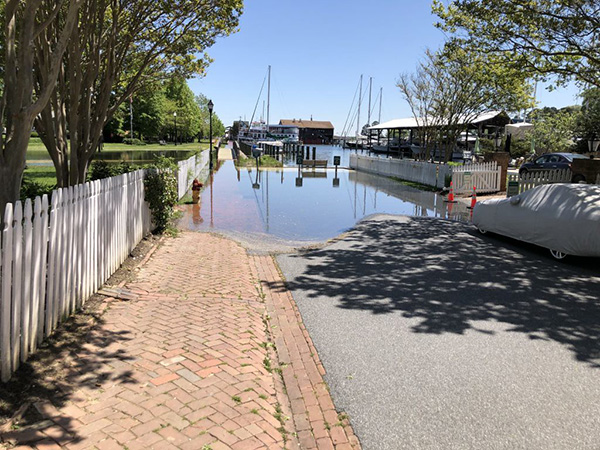Climate Partnerships and Strategies
Main_Content
Planning for and responding to climate change in Maryland is a big task–and the Maryland Department of Natural Resources is leveraging partnerships across the state in order to build climate resilience. Working with state initiatives and coordinating with public and private
programs, DNR and its partners are preparing the state for the many effects of climate change, from protecting shorelines to developing adaptive strategies.
Chesapeake Bay Partnership

The Chesapeake Bay Partnership was established via the
Chesapeake Bay Watershed Agreement to enhance the health of the Chesapeake Bay and its watershed. Among the goals in the agreement is the Climate Resiliency goal to “increase the resiliency of the Chesapeake Bay watershed, including its living resource, habitats, public infrastructure and communities, to withstand adverse impacts from changing environmental and climate conditions.”
Maryland is a leader among the Partnership. Governor Wes Moore serves on the Executive Council and Secretary Josh Kurtz serves on the Principal Staff Committee ensuring that the Partnership is politically and strategically positioned to successfully restore and protect the Chesapeake Bay.
Back to Top
Coast Smart Council

Established by the Maryland General Assembly in 2014, the Maryland
Coast Smart Council outlines siting and design criteria to address impacts associated with sea level rise and coastal flooding on proposed state and local capital projects.
The
Coast Smart Construction Program, aims to make state projects climate resilient. These common-sense guidelines create long-term savings for the state, while ensuring that construction is undertaken responsibly in areas prone to flood risks.
Critical Area Commission

The Chesapeake Bay
Critical Area Commission protects the ribbon of land within 1000 feet of the tidal influence of the Bay, critical areas that have direct and immediate effects on the health of the Bay as a whole.
The Commission helps minimize negative consequences of human activities on water quality and wildlife habitats. Taking a proactive approach, the Commission seeks to foster consistent and more sensitive development–that also supports climate adaptation–within the critical area.
Back to Top
DNR’s Climate Implementation Plan

Maryland's plan is to achieve its near-term climate goals and place the state on a path to achieve net-zero emissions by 2045. Each
state agency has its own Climate Implementation Plan to reach those goals.
DNR’s Climate Implementation Plan details the department’s work to plant trees, protect shorelines, sequester carbon, invest in renewable energy, bolster regenerative agriculture, and other strategies to support the state’s climate objectives. The plan lays out resources for implementing these efforts, as well as the consequences of the projects, which will create jobs, ensure equity, and protect habitats.
Fisheries Advisory Bodies

The Sport Fisheries Advisory Commission, Tidal Fisheries Advisory Commission, Oyster Advisory Commission, and Aquaculture Coordinating Council advise the director of DNR’s Fishing and Boating Services on matters related to
fisheries management. These commissions comprise individuals from across the state, representing constituencies in commercial and recreational fisheries, charter fisheries, aquaculture, and invasive species. Though climate change is not the primary driver for fisheries management, it has the potential to impact various components of the management system and requires collaborative action with fishing communities.
Back to Top
Interjurisdictional Fisheries Management
Maryland Resiliency Partnership

The
Maryland Resiliency Partnership brings together public and private partners to improve the resilience of Maryland communities to flood and climate hazards.
Flooding is the most prevalent natural hazard in Maryland, and climate change increases the severity and frequency of flooding. This partnership focuses on planning and preparedness to protect life, property, and natural resources, today and for future generations.
Back to Top
Maryland Urban and Community Forest Committee

The Maryland Urban and Community Forest Committee is a volunteer group of citizens, professionals, and government officials united to protect and enhance Maryland’s forest ecosystems. MUCFC is a sub-committee of the Maryland Association of Forest Conservancy District Boards. The primary functions of the Committee are to promote and coordinate the Maryland Community PLANT Award Program that officially recognizes communities planting and caring for trees, and to administer Grants to schools and communities through their local Forestry Boards that promote planting and care of trees.
Outdoor Learning Partnership
Rural Legacy Board and Advisory Committee

The
Rural Legacy Board and
Advisory Committee make recommendations on grant funding to protect working farms and forests in Maryland. Though climate resilience is not the driver for land protection, preservation of our natural areas enhances Maryland’s resilience to climate impacts.
Sustainable Forestry Council

The
Sustainable Forestry Council is a governor-appointed council that advises the Department of Natural Resources on timely forest conservation issues and appropriate actions to help Maryland implement a no net loss of forest policy.
Back to Top